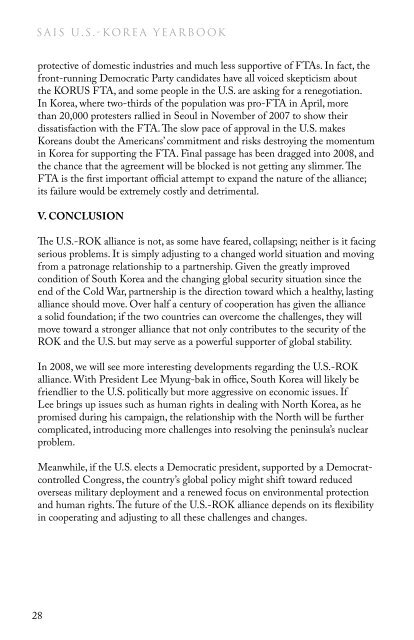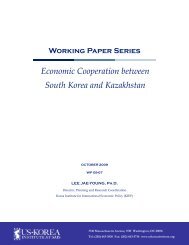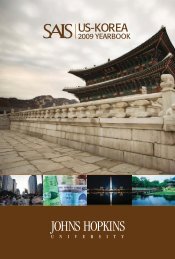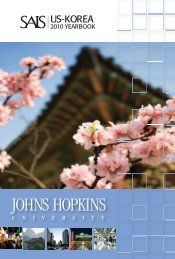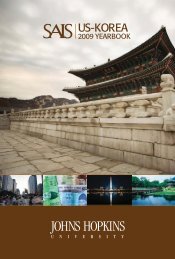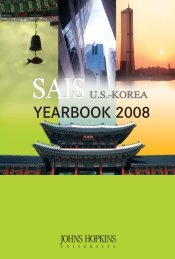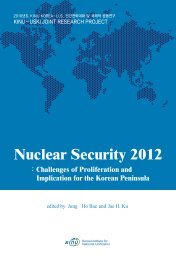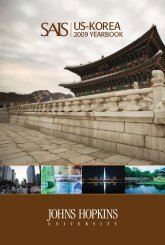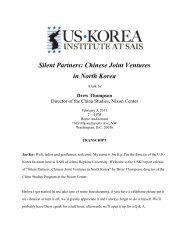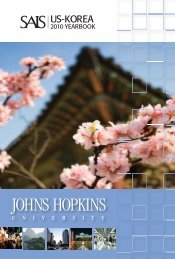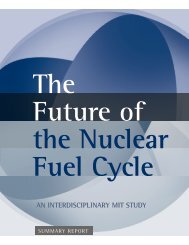YeArBooK 2007 - US-Korea Institute at SAIS
YeArBooK 2007 - US-Korea Institute at SAIS
YeArBooK 2007 - US-Korea Institute at SAIS
You also want an ePaper? Increase the reach of your titles
YUMPU automatically turns print PDFs into web optimized ePapers that Google loves.
saIs U.s.-<strong>Korea</strong> YearbooK<br />
protective of domestic industries and much less supportive of FTAs. In fact, the<br />
front-running Democr<strong>at</strong>ic Party candid<strong>at</strong>es have all voiced skepticism about<br />
the KOR<strong>US</strong> FTA, and some people in the U.S. are asking for a renegoti<strong>at</strong>ion.<br />
In <strong>Korea</strong>, where two-thirds of the popul<strong>at</strong>ion was pro-FTA in April, more<br />
than 20,000 protesters rallied in Seoul in November of <strong>2007</strong> to show their<br />
diss<strong>at</strong>isfaction with the FTA. The slow pace of approval in the U.S. makes<br />
<strong>Korea</strong>ns doubt the Americans’ commitment and risks destroying the momentum<br />
in <strong>Korea</strong> for supporting the FTA. Final passage has been dragged into 2008, and<br />
the chance th<strong>at</strong> the agreement will be blocked is not getting any slimmer. The<br />
FTA is the first important official <strong>at</strong>tempt to expand the n<strong>at</strong>ure of the alliance;<br />
its failure would be extremely costly and detrimental.<br />
28<br />
V. ConCl<strong>US</strong>Ion<br />
The U.S.-ROK alliance is not, as some have feared, collapsing; neither is it facing<br />
serious problems. It is simply adjusting to a changed world situ<strong>at</strong>ion and moving<br />
from a p<strong>at</strong>ronage rel<strong>at</strong>ionship to a partnership. Given the gre<strong>at</strong>ly improved<br />
condition of South <strong>Korea</strong> and the changing global security situ<strong>at</strong>ion since the<br />
end of the Cold War, partnership is the direction toward which a healthy, lasting<br />
alliance should move. Over half a century of cooper<strong>at</strong>ion has given the alliance<br />
a solid found<strong>at</strong>ion; if the two countries can overcome the challenges, they will<br />
move toward a stronger alliance th<strong>at</strong> not only contributes to the security of the<br />
ROK and the U.S. but may serve as a powerful supporter of global stability.<br />
In 2008, we will see more interesting developments regarding the U.S.-ROK<br />
alliance. With President Lee Myung-bak in office, South <strong>Korea</strong> will likely be<br />
friendlier to the U.S. politically but more aggressive on economic issues. If<br />
Lee brings up issues such as human rights in dealing with North <strong>Korea</strong>, as he<br />
promised during his campaign, the rel<strong>at</strong>ionship with the North will be further<br />
complic<strong>at</strong>ed, introducing more challenges into resolving the peninsula’s nuclear<br />
problem.<br />
Meanwhile, if the U.S. elects a Democr<strong>at</strong>ic president, supported by a Democr<strong>at</strong>controlled<br />
Congress, the country’s global policy might shift toward reduced<br />
overseas military deployment and a renewed focus on environmental protection<br />
and human rights. The future of the U.S.-ROK alliance depends on its flexibility<br />
in cooper<strong>at</strong>ing and adjusting to all these challenges and changes.<br />
U.s.-roK allIanCe: looKInG ToWard THe fUTUre<br />
Chronology<br />
2/13/07 Third session of the third round of the Six-Party Talks; initial actions<br />
to implement the forum’s joint st<strong>at</strong>ement.<br />
3/05/07 Six-Party Talks; meeting in New York of U.S.-DPRK bil<strong>at</strong>eral working<br />
group.<br />
4/02/07 U.S. and <strong>Korea</strong> conclude FTA agreement.<br />
4/08/07 U.S. deleg<strong>at</strong>ion to North <strong>Korea</strong>.<br />
4/13/07 DPRK reaffirms commitment to implement the February 13<br />
agreement and willingness to move when the BDA resolution “is<br />
proved to be a reality.”<br />
5/01/07 Joint st<strong>at</strong>ement of the U.S.-Japan Security Consult<strong>at</strong>ive Committee.<br />
6/11/07 Assistant Secretary of St<strong>at</strong>e Christopher Hill meets with ROK Vice<br />
Foreign Minister Chun Young-woo.<br />
6/14/07 North <strong>Korea</strong> receives money th<strong>at</strong> had been frozen <strong>at</strong> BDA.<br />
7/14/07 North <strong>Korea</strong> shuts down Yongbyon nuclear facilities.<br />
7/26/07 U.S. responds to flooding in North <strong>Korea</strong>.<br />
8/28/07 Inaugural inter-<strong>Korea</strong> summit.<br />
10/03/07 Six-Party Talks agreement on “second-phase actions for the<br />
implement<strong>at</strong>ion of the joint st<strong>at</strong>ement.”<br />
10/11/07 U.S.-ROK str<strong>at</strong>egic consult<strong>at</strong>ions for allied partnership,<br />
subministerial session.<br />
11/16/07 President George W. Bush welcomes Japanese Prime Minister Yasuo<br />
Fukuda to Washington, D.C.<br />
11/27/07 Defense ministers of North and South <strong>Korea</strong> begin talks.<br />
12/11/07 The New York Philharmonic agrees to visit North <strong>Korea</strong>.<br />
12/11/07 Beginning of a cross-border rail link between the two <strong>Korea</strong>s.<br />
12/30/07 North <strong>Korea</strong> fails to declare all components of its uranium<br />
enrichment program by the year’s end.<br />
29


